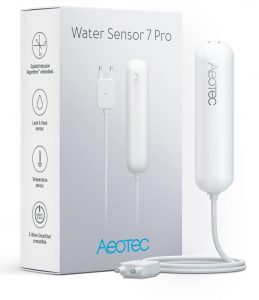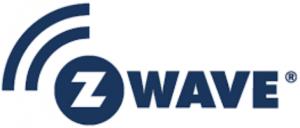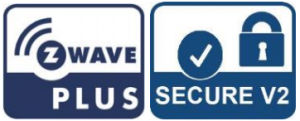AeoTec Water Sensor 7 Pro

QuickStart
This is a secure Alarm Sensor for Europe. To run this device please insert fresh 1 * 1/2 AA batteries. Please make sure the internal battery is fully charged. The DSK for the S2 inclusion can be found inside the sensors packaging.If your Z-Wave gateway supports SmartStart: scan the QR code on Water Sensor 7 Pro using the gateway’s app. Your sensor will join your Z-Wave network automatically
Important safety information
Please read this manual carefully. Failure to follow the recommendations in this manual may be dangerous or may violate the law. The manufacturer, importer, distributor and seller shall not be liable for any loss or damage resulting from failure to comply with the instructions in this manual or any other material. Use this equipment only for its intended purpose. Follow the disposal instructions. Do not dispose of electronic equipment or batteries in a fire or near open heat sources
What is Z-Wave™?

Z-Wave is the international wireless protocol for communication in the Smart Home. This device is suited for use in the region mentioned in the QuickStart section.
Z-Wave ensures a reliable communication by reconfirming every message (two-way communication) and every mains powered node can act as a repeater for other nodes (meshed network) in case the receiver is not in direct wireless range of the transmitter.
This device and every other certified Z-Wave device can be used together with any other certified Z-Wave device regardless of brand and origin as long as both are suited for the same frequency range.
If a device supports secure communication it will communicate with other devices secure as long as this device provides the same or a higher level of security. Otherwise it will automatically turn into a lower level of security to maintain backward compatibility.
SmartStart. Available in selected Z-Wave Plus devices built upon 500 series technology and all devices built upon 700 series technology, SmartStart lets you setup Z-Wave devices in seconds. Using SmartStart enabled apps, simply scan the QR code on any compatible app to connect it to your Z Wave gateway.
For more information about Z-Wave technology, devices, white papers etc. please refer to www.z-wave.info.
Product Description
The AEOTEC Water Sensor 7 Pro is a sensor, which detects water leakage, measures temperature and humidity. The sensor is easily retrofittable.
Thanks to its slim design the AEOTEC Water Sensor 7 Pro can be installed in any bathroom, behind a kitchen sink or in any other tight space. The sensor just has to be installed on the wall and the sensor probe must be put on the floor.
By using the internal temperature and humidity sensor, the device will report on any significant change.
Triple clicking the tamper button includes (adds) and excludes (removes) the device. A single click on the button will wake up the device. The device supports the Z-Wave Security S2 framework with authenticated and unauthenticated network keys. Please follow the instructions on the central controller when including. The device also supports SmartStart.
Prepare for Installation / Reset
Please read the user manual before installing the product.
In order to include (add) a Z-Wave device to a network it must be in factory default state. Please make sure to reset the device into factory default. You can do this by performing an Exclusion operation as described below in the manual. Every Z-Wave controller is able to perform this operation however it is recommended to use the primary controller of the previous network to make sure the very device is excluded properly from this network.
Reset to factory defaultThis device also allows to be reset without any involvement of a Z-Wave controller. This procedure should only be used when the primary controller is inoperable.
Once Cover is removed and the tamper switch is tripped, push the tamper for 5 seconds until the RED LED blinks once. Then release tamper and push it again for 5 seconds while the RED LED is blinking until the GREEN LED blinks once.
Safety Warning for BatteriesThe product contains batteries. Please remove the batteries when the device is not used. Do not mix batteries of different charging level or different brands.
Installation
The sensor can be mounted on the wall. Mounting can be accomplished either using the tape by peeling off the protection foil or using two screws with the holes inside the battery compartment. Water Sensor probe which is hardwired to the Main Unit must be put on the floor or onto any other surface, where water leakage must be detected.
Inclusion/Exclusion
On factory default the device does not belong to any Z-Wave network. The device needs to be added to an existing wireless network to communicate with the devices of this network. This process is called Inclusion.
Devices can also be removed from a network. This process is called Exclusion. Both processes are initiated by the primary controller of the Z-Wave network. This controller is turned into exclusion respective inclusion mode. Inclusion and Exclusion is then performed doing a special manual action right on the device.
Inclusion (If your gateway does not support SmartStart)
- Open the housing.
- Remove the battery protection.
- Press the tamper on the side of the appliance three times quickly
Exclusion
- Open the housing.
- Press the tamper on the side of the appliance three times quickly.
Product Usage
Once installed the sensor will report Leakage Detected and No Leakage status changes to a central Z-Wave controller using notification commands. Additionally, the sensor can directly control other devices using the association group 2. The device is protected by a tamper switch.
The device contains two sensors with the following accuracy measures:
- Humidity: ± 3% RH (max), 0– 80% RH
- Temperature: ±0.4 °C (max), – 10 to 85 °C
Water leakage detection
The water leakage detection allows reporting as soon as water hits the sensor probe. This is accomplished using the command class notification – water alarm – water leakage detected unknown location. After the leakage has stopped (the sensor probes are not short-connected through the water) the device reports this to the central controller.
Link testing
When activated by configuration parameter #4 the device can perform a link test with device No.1. Double-clicking the tamper will start the process. As a result, the GREEN LED will blink one time in case of success and RED LED will blink three times in case of failure.
The device sends the following notifications to the central controller:
- Water Leakage Unknown Location (0x05 – 0x02)
- Tamper Removed (0x07 – 0x03)
- Replace Battery Now (0x08 – 0x0b)
Node Information Frame
The Node Information Frame (NIF) is the business card of a Z-Wave device. It contains information about the device type and the technical capabilities. The inclusion and exclusion of the device is confirmed by sending out a Node Information Frame. Beside this it may be needed for certain network operations to send out a Node Information Frame. To issue a NIF execute the following action: Press the tamper once
Quick trouble shooting
Here are a few hints for network installation if things don’t work as expected.
- Make sure a device is in factory reset state before including. In doubt exclude before include.
- If inclusion still fails, check if both devices use the same frequency.
- Remove all dead devices from associations. Otherwise you will see severe delays.
- Never use sleeping battery devices without a central controller.
- Don’t poll FLIRS devices.
- Make sure to have enough mains powered device to benefit from the meshing
Firmware-Update over the Air
This device is capable of receiving a new firmware ‘over the air’. The update function needs to be supported by the central controller. Once the controller starts the update process, perform the following action to confirm the firmware update: Wake Up the device by removing the cover. Then hit the tamper switch once.
Association – one device controls an other device
Z-Wave devices control other Z-Wave devices. The relationship between one device controlling another device is called association. In order to control a different device, the controlling device needs to maintain a list of devices that will receive controlling commands. These lists are called association groups and they are always related to certain events (e.g. button pressed, sensor triggers, …). In case the event happens all devices stored in the respective association group will receive the same wireless command wireless command, typically a ‘Basic Set’ Command.
Association Groups:
| Group Number | Maximum Nodes | Description |
| 1 | 5 | Lifeline |
| 2 | 5 | Control devices when water leakage is detected |
| 3 | 5 | Sends out alarm message when water leakage is detected |
| 4 | 5 | Sends out alarm messages when tamper is tripped |
Configuration Parameters
Z-Wave products are supposed to work out of the box after inclusion, however certain configuration can adapt the function better to user needs or unlock further enhanced features.
IMPORTANT: Controllers may only allow configuring signed values. In order to set values in the range 128 255 the value sent in the application shall be the desired value minus 256. For example: To set a parameter to 200 it may be needed to set a value of 200 minus 256 = minus 56. In case of a two byte value the same logic applies: Values greater than 32768 may needed to be given as negative values too.
Parameter 3: Visual LED IndicationsThis parameter defines when LEDs will indicate events. Disabling all indications may extend battery life.Value 0 means – No Indications.Size: 1 Byte, Default Value: 7 (values 1 + 2 + 4 summarized)
| Setting | Description |
| 1 | Water Leakage Status Change |
| 2 | Wake Up |
| 4 | Device Tampering |
Parameter 4: Range Test after double clickAllows to enable the a Z-Wave range test with double clicking the tamper switch. The green LED indicates thesensor is in the range and the red LED indicates, its out of range.Size: 1 Byte, Default Value: 0
| Setting | Description |
| 0 | Disabled |
| 1 | Enabled |
Parameter 5: 2nd Association Group TriggerThis parameter defines the status of the water leakage that causes sending a BASIC command to all devices of Association Group 2.Size: 1 Byte, Default Value: 0
| Setting | Description |
| 0 | Switch after Water Leakage Start and Stop |
| 1 | Switch after Water Leakage Start |
| 2 | Switch after Water Leakage Stop |
Parameter 6: Command Sent to Devices of Association Group 2This parameter defines which commands is sent to 2nd Association Group Size: 1 Byte, Default Value: 2
| Setting | Description |
| 1 | On |
| 2 | Off |
| 2 | On and Off |
Parameter 7: BASIC command value sent to 2nd Association Group on On eventThis is the BASIC command value sent in case of On event. Size: 1 Byte, Default Value: 255
| Setting | Description |
| 0 – 99 | Value |
| 255 | Value |
Parameter 8: BASIC command value sent to 2nd Association Group on Off eventThis is the BASIC command value sent in case of Off event.Size: 1 Byte, Default Value: 0
| Setting | Description |
| 0 – 99 | Value |
| 255 | Value |
Parameter 9: Time Delay of On command frameOn command is sent after a delay defined in this parameter.Size: 2 Byte, Default Value: 0
| Setting | Description |
| 0 – 32400 | seconds |
Parameter 10: Time Delay of Off command frameOff command is sent after a delay defined in this parameter.Size: 2 Byte, Default Value: 0
| Setting | Description |
| 0 – 32400 | seconds |
Parameter 11: Delay of Tamper Alarm CancellationTime a tamper alarm is delayed.Size: 2 Byte, Default Value: 0
| Setting | Description |
| 0 – 32400 | seconds |
Parameter 12: Reporting Tamper Alarm CancellationThis parameter defines if the alarm cancellation event is reported.Size: 1 Byte, Default Value: 1
| Setting | Description |
| 0 | Do not send Report |
| 1 | Send Report |
Parameter 16: Minimum Temperature change to reportThis value defines the minimum change of temperature to cause an unsolicited report of temperature to the central controller using Lifeline.If the value is set to 0, there will be no reports sent to the controller, when the temperature changes. However, periodic reports, managed by configuration parameter 18, may still be active. Size: 1 Byte, Default Value: 20
| Setting | Description |
| 0 | Disabled |
| 1 – 100 | 1/10 degree |
Parameter 17: Minimum humidity change to reportThis value defines the minimum change of humidity to cause an unsolicited report of humidity to the central controller using Lifeline.If the value is set to 0, there will be no reports sent to the controller, when the humidity changes. However, periodic reports, managed by configuration parameter 18, may still be active.Size: 1 Byte, Default Value: 5
| Setting | Description |
| 0 | Disabled |
| 1 – 20 | % |
Parameter 18: Periodic ReportsThis parameter defines the time interval to send an unsolicited report.If the value is set to 0, there will be no periodic reports sent to the controller. However, reports on temperature/humidity changes, managed by configuration parameters 16 and 17, may still be active.Size: 2 Byte, Default Value: 43200
| Setting | Description |
| 0 | Disabled |
| 900 – 65535 | Seconds |
Parameter 255: Reset ParameterThis parameter helps reset configuration parameters and the device to factory defaultsSize: 4 Byte, Default Value: 0
| Setting | Description |
| 1 – 1431655764 (0x55555554) | Reset all Parameter settings to their default settings. |
| 1431655765 | Completely factory reset sensor and send device reset locally notification. |
Technical Data
| Dimensions | 28x95x35 mm |
| Hardware Platform | ZGM130S |
| IP Class | IP 20 |
| Battery Type | 1 * 1/2 AA |
| Device Type | Notification Sensor |
| Generic Device Class | Sensor Notification |
| Specific Device Class | Routing Sensor Notification |
| Network Operation | Reporting Sleeping Slave |
| Firmware Version | 01.00 |
| Z-Wave Version | 07.12 |
| Z-Wave Product Id | 0371.0002.0013 |
| Frequency | Europe – 868,4 Mhz |
| Maximum transmission power | 5 mW |
Supported Command Classes
- Configuration Command Class, Version 4 (highest granted security level)
- Multilevel Sensor Command Class, Version 11 (highest granted security level)
- Multi Channel Association Command Class, Version 3 (highest granted security level)
- Association Group Information Command Class, Version 3 (highest granted security level)
- Device Reset Locally Command Class, Version 1 (highest granted security level)
- Z-Wave Plus Info Command Class, Version 2 (non-Secure)
- Notification Command Class, Version 8 (highest granted security level)
- Manufacturer Specific Command Class, Version 2 (highest granted security level)
- Powerlevel Command Class, Version 1 (highest granted security level)
- Firmware Update Meta Data Command Class, Version 5 (highest granted security level)
- Battery Command Class, Version 1 (highest granted security level)
- Wake Up Command Class, Version 2 (highest granted security level)
- Indicator Command Class, Version 3 (highest granted security level)
- Association Command Class, Version 2 (highest granted security level)
- Version Command Class, Version 3 (highest granted security level)
- Security 2 Command Class, Version 1 (highest granted security level)
- Supervision Command Class, Version 1 (non-Secure)
- Transport Service Command Class, Version 2 (non-Secure)
Explanation of Z-Wave specific terms
- Controller — is a Z-Wave device with capabilities to manage the network. Controllers are typically Gateways, Remote Controls or battery operated wall controllers.
- Slave — is a Z-Wave device without capabilities to manage the network. Slaves can be sensors, actuators and even remote controls.
- Primary Controller — is the central organizer of the network. It must be a controller. There can be only one primary controller in a Z-Wave network.
- Inclusion — is the process of adding new Z-Wave devices into a network
- Exclusion — is the process of removing Z-Wave devices from the network.
- Association — is a control relationship between a controlling device and a controlled device.
- Wakeup Notification — is a special wireless message issued by a Z-Wave device to announces that is able to communicate.
- Node Information Frame — is a special wireless message issued by a Z-Wave device to announce its capabilities and functions.


References
[xyz-ips snippet=”download-snippet”]

